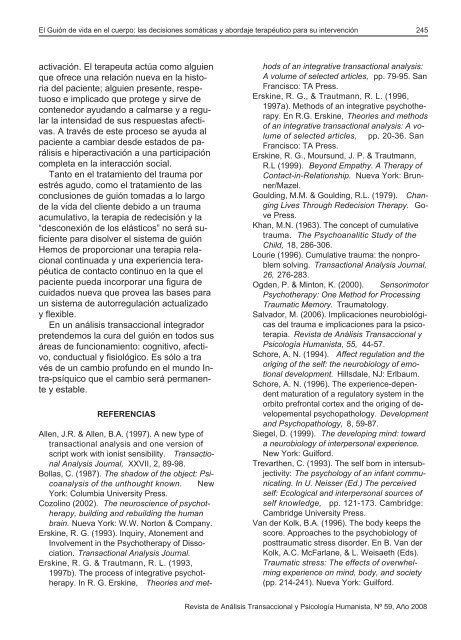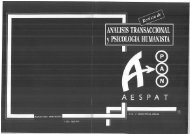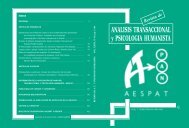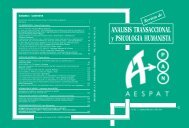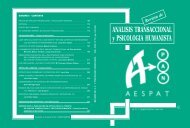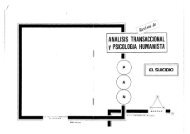El Guión de vida en el cuerpo: las decisiones somáticas y abordaje terapéutico para su intervención 245activación. El terapeuta actúa como alguienque ofrece una relación nueva en la historiadel paciente; alguien presente, respetuosoe implicado que protege y sirve decontenedor ayudando a calmarse y a regularla intensidad de sus respuestas afectivas.A través de este proceso se ayuda alpaciente a cambiar desde estados de parálisise hiperactivación a una participacióncompleta en la interacción social.Tanto en el tratamiento del trauma porestrés agudo, como el tratamiento de lasconclusiones de guión tomadas a lo largode la vida del cliente debido a un traumaacumulativo, la terapia de redecisión y la“desconexión de los elásticos” no será suficientepara disolver el sistema de guiónHemos de proporcionar una terapia relacionalcontinuada y una experiencia terapéuticade contacto continuo en la que elpaciente pueda incorporar una figura decuidados nueva que provea las bases paraun sistema de autorregulación actualizadoy flexible.En un análisis transaccional integradorpretendemos la cura del guión en todos susáreas de funcionamiento: cognitivo, afectivo,conductual y fisiológico. Es sólo a través de un cambio profundo en el mundo Intra-psíquicoque el cambio será permanentey estable.REFERENCIASAllen, J.R. & Allen, B.A. (1997). A new type oftransactional analysis and one version ofscript work with ionist sensibility. TransactionalAnalysis Journal, <strong>XXVI</strong>I, 2, 89-98.Bollas, C. (1987). The shadow of the object: Psicoanalysisof the unthought known. NewYork: Columbia University Press.Cozolino (2002). The neuroscience of psychotherapy,building and rebuilding the humanbrain. Nueva York: W.W. Norton & Company.Erskine, R. G. (1993). Inquiry, Atonement andInvolvement in the Psychotherapy of Dissociation.Transactional Analysis Journal.Erskine, R. G. & Trautmann, R. L. (1993,1997b). The process of integrative psychotherapy.In R. G. Erskine, Theories and methodsof an integrative transactional analysis:A volume of selected articles, pp. 79-95. SanFrancisco: TA Press.Erskine, R. G., & Trautmann, R. L. (1996,1997a). Methods of an integrative psychotherapy.En R.G. Erskine, Theories and methodsof an integrative transactional analysis: A volumeof selected articles, pp. 20-36. SanFrancisco: TA Press.Erskine, R. G., Moursund, J. P. & Trautmann,R.L (1999). Beyond Empathy. A Therapy ofContact-in-Relationship. Nueva York: Brunner/Mazel.Goulding, M.M. & Goulding, R.L. (1979). ChangingLives Through Redecision Therapy. GovePress.Khan, M.N. (1963). The concept of cumulativetrauma. The Psychoanalitic Study of theChild, 18, 286-306.Lourie (1996). Cumulative trauma: the nonproblemsolving. Transactional Analysis Journal,26, 276-283.Ogden, P. & Minton, K. (2000). SensorimotorPsychotherapy: One Method for ProcessingTraumatic Memory. Traumatology.Salvador, M. (2006). Implicaciones neurobiológicasdel trauma e implicaciones para la psicoterapia.Revista de Análisis Transaccional yPsicología Humanista, 55, 44-57.Schore, A. N. (1994). Affect regulation and theoriging of the self: the neurobiology of emotionaldevelopment. Hillsdale, NJ: Erlbaum.Schore, A. N. (1996). The experience-dependentmaturation of a regulatory system in theorbito prefrontal cortex and the origing of developementalpsychopathology. Developmentand Psychopathology, 8, 59-87.Siegel, D. (1999). The developing mind: towarda neurobiology of interpersonal experience.New York: Guilford.Trevarthen, C. (1993). The self born in intersubjectivity:The psychology of an infant communicating.In U. Neisser (Ed.) The perceivedself: Ecological and interpersonal sources ofself knowledge, pp. 121-173. Cambridge:Cambridge University Press.Van der Kolk, B.A. (1996). The body keeps thescore. Approaches to the psychobiology ofposttraumatic stress disorder. En B. Van derKolk, A.C. McFarlane, & L. Weisaeth (Eds).Traumatic stress: The effects of overwhelmingexperience on mind, body, and society(pp. 214-241). Nueva York: Guilford.Revista de Análisis Transaccional y Psicología Humanista, Nº 59, Año 2008
246 Mario C. SalvadorBIBLIOGRAFÍAHerman, J.L. (1994). Trauma and Recovery.Nueva York: Harper & Collins Publishers.Ogden, P., Minton, K. & Pain, C. (2006). SensorimotorPsychotherapy: One Method forProcessing Traumatic Memory. Nueva York:W.W. Norton & Company, Inc.Parnell, L. (1999). EMDR in the treatment of AdultsAbused as Children. Norton: Professional Book.Rothschild, B. (2000). The Body Remembers.The psychophysiology of Trauma and TraumaTreatment. Norton: Professional Book.Shapiro, F. (1995). Eye Movement, Desensitizationand Reprocessing Basic Principle, Protocolsand Procedures. Nueva York: Guildford Press.Van der Hart, O. Ph.D., Kathy Steele, R.N.,M.N., C.S.Suzette Boon, Ph.D. and Paul Brown, M.D.(1993). The Treatment of Traumatic Memories:Synthesis, Realization, and Integration.Dissociation, 6(2/3), 162-180. Posted atwww.trauma-pages.com with permission ofthe first author (OvdH) and Editor (R. Kluft).Van der Kolk, B.A, & Ducey, C.P. (1989). Thepsychological processing of traumatic experience:Rorschach patterns. J Traum Stress,2, 259-274.Van der Kolk, B.A. & Van der Hart, O. (1991).The intrusive past: The flexibility of memorand the engraving of trauma. American Imago,48, 425-454.Recibido: 28 de Agosto, 2008Evaluado: 30 de Octubre, 2008Aceptado: 15 de Noviembre, 2008Revista de Análisis Transaccional y Psicología Humanista, Nº 59, Año 2008
- Page 1 and 2: ÍNDICEEDITORIAL REVISTA DE ANÁLIS
- Page 3 and 4: 202ÍNDICEEDITORIAL REVISTA DE ANÁ
- Page 5 and 6: 204TABLE DE MATIÈRESEDITORIAL DU M
- Page 7 and 8: 206guaje de AT con garantías de ri
- Page 9 and 10: 208 Mariano Bucero RomanillosMás a
- Page 11 and 12: 210 Mariano Bucero RomanillosAllpor
- Page 13 and 14: 212 Mariano Bucero Romanillos1975 c
- Page 15 and 16: 214 Mariano Bucero Romanillosvament
- Page 17 and 18: 216 Mariano Bucero Romanillos➡Pue
- Page 19 and 20: 218 Mariano Bucero RomanillosOtra s
- Page 21 and 22: 220 Mariano Bucero Romanillosvez co
- Page 23 and 24: 222 Mariano Bucero Romanilloscortas
- Page 25 and 26: 224 Mariano Bucero Romanillosél y
- Page 27 and 28: 226 Mariano Bucero Romanillosque di
- Page 29 and 30: 228 Mariano Bucero RomanillosTabla
- Page 31 and 32: 230 Mariano Bucero Romanillos➡Tab
- Page 33 and 34: 232 Mariano Bucero RomanillosTabla
- Page 35 and 36: 234 Mariano Bucero Romanillos➡ Ta
- Page 37 and 38: 236 Mariano Bucero RomanillosREFERE
- Page 39 and 40: 238 Mario C. SalvadorEL GUIÓN DE V
- Page 41 and 42: 240 Mario C. Salvadorciones interna
- Page 43 and 44: 242 Mario C. Salvadorsarrollo. Asim
- Page 45: 244 Mario C. Salvadorlación, el pa
- Page 49 and 50: 248 Rafael Sáez AlonsoANALYSE FONT
- Page 51 and 52: 250 Rafael Sáez AlonsoNutritivo Pe
- Page 53 and 54: 252 Rafael Sáez AlonsoNiño Adapta
- Page 55 and 56: 254 Rafael Sáez AlonsoFigura 3: Ex
- Page 57 and 58: 256 Rafael Sáez Alonsotérminos de
- Page 59 and 60: 258 Rafael Sáez AlonsoLa definici
- Page 61 and 62: 260 Rafael Sáez Alonsotimulante ha
- Page 63 and 64: 262 Rafael Sáez AlonsoOtros tipos
- Page 66 and 67: Análisis funcional de la personali
- Page 68 and 69: Ciberadicción: Los riesgos de Inte
- Page 70 and 71: Ciberadicción: Los riesgos de Inte
- Page 72 and 73: Ciberadicción: Los riesgos de Inte
- Page 74 and 75: Ciberadicción: Los riesgos de Inte
- Page 76 and 77: Ciberadicción: Los riesgos de Inte
- Page 78 and 79: Ciberadicción: Los riesgos de Inte
- Page 80 and 81: Ciberadicción: Los riesgos de Inte
- Page 82 and 83: Ciberadicción: Los riesgos de Inte
- Page 84 and 85: Ciberadicción: Los riesgos de Inte
- Page 86 and 87: Ciberadicción: Los riesgos de Inte
- Page 88 and 89: Ciberadicción: Los riesgos de Inte
- Page 90 and 91: Ciberadicción: Los riesgos de Inte
- Page 92 and 93: Ciberadicción: Los riesgos de Inte
- Page 94 and 95: Ciberadicción: Los riesgos de Inte
- Page 96 and 97:
Ciberadicción: Los riesgos de Inte
- Page 98 and 99:
Psicología Clínica: contenidos y
- Page 100 and 101:
Psicología Clínica: contenidos y
- Page 102 and 103:
Psicología Clínica: contenidos y
- Page 104 and 105:
Psicología Clínica: contenidos y
- Page 106 and 107:
Psicología Clínica: contenidos y
- Page 108 and 109:
Psicología Clínica: contenidos y
- Page 110 and 111:
Psicología Clínica: contenidos y
- Page 112 and 113:
Psicología Clínica: contenidos y
- Page 114 and 115:
Psicología Clínica: contenidos y
- Page 116 and 117:
Psicología Clínica: contenidos y
- Page 118 and 119:
Psicología Clínica: contenidos y
- Page 120 and 121:
Psicología Clínica: contenidos y
- Page 122 and 123:
Sobre el niño retraído: otro esta
- Page 124 and 125:
Sobre el niño retraído: otro esta
- Page 126 and 127:
Sobre el niño retraído: otro esta
- Page 128 and 129:
Sobre el niño retraído: otro esta
- Page 130 and 131:
Sobre el niño retraído: otro esta
- Page 132 and 133:
Sobre el niño retraído: otro esta
- Page 134 and 135:
Sobre el niño retraído: otro esta
- Page 136 and 137:
El suicida: ser matado, matarse, mo
- Page 138 and 139:
El suicida: ser matado, matarse, mo
- Page 140 and 141:
El suicida: ser matado, matarse, mo
- Page 142 and 143:
El suicida: ser matado, matarse, mo
- Page 144 and 145:
Cómo hacer a una persona pasivo-ag
- Page 146 and 147:
Cómo hacer a una persona pasivo-ag
- Page 148 and 149:
Cómo hacer a una persona pasivo-ag
- Page 150 and 151:
Cómo hacer a una persona pasivo-ag
- Page 152 and 153:
Los contratos 351dran en ella un si
- Page 154 and 155:
Los contratos 353ra cuando una figu
- Page 156 and 157:
Los contratos 355inadecuado y pierd
- Page 158 and 159:
Los contratos 357Ovsiankina, M. (19
- Page 160 and 161:
359OBITUARIOSEN RECUERDO DE CARLO M
- Page 162 and 163:
361PUBLICIDAD DE CURSOS Y CONGRESOS
- Page 164 and 165:
3636. Transacciones y estructuraci
- Page 166 and 167:
365DURACIÓN DEL CURSO : 100 horas.
- Page 168 and 169:
367DURACIÓN:(Selecciona una)1.5 ho
- Page 170 and 171:
369NOVEDADES BIBLIOGRÁFICASANALISI
- Page 172 and 173:
371VIVIR INTERCULTURALMENTE: APREND
- Page 174 and 175:
373Para buscar ese sentido, Berne s
- Page 176 and 177:
375Juicio crítico. Nos encontramos
- Page 178 and 179:
377posibilidades, lo que, en el cas
- Page 180 and 181:
379Otra cuestión que quiero coment
- Page 182 and 183:
381autores expertos en la teoría y
- Page 184 and 185:
383heimer y sus discípulos trabaja
- Page 186 and 187:
385- Las Referencias Bibliográfica
- Page 188 and 189:
387tre paréntesis. Por ej.: Valbue
- Page 190 and 191:
389cursiva) y página (s) del susod
- Page 192 and 193:
391CARTAS AL DIRECTORSegún las NOR
- Page 194:
ASOCIACIÓN ESPAÑOLA DE ANÁLISIS


